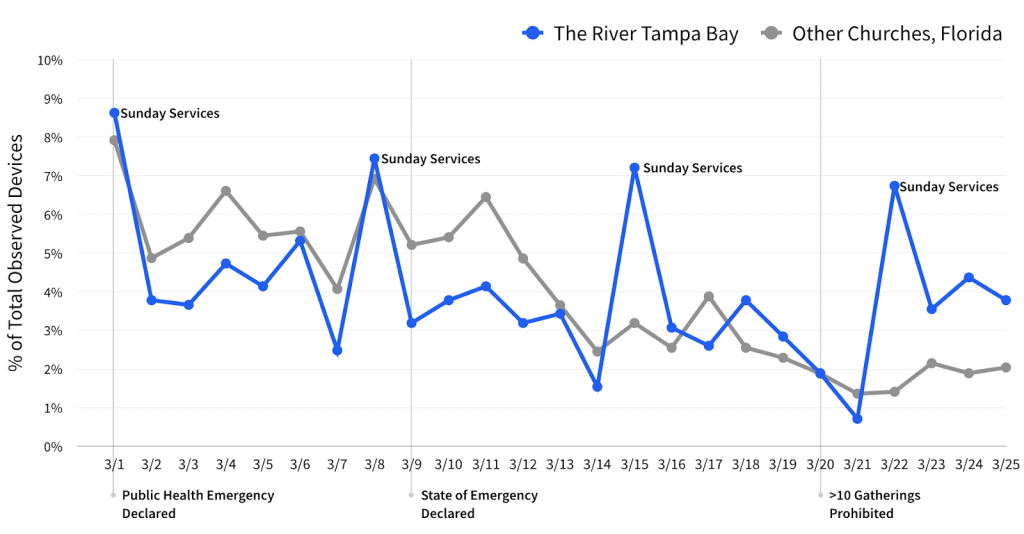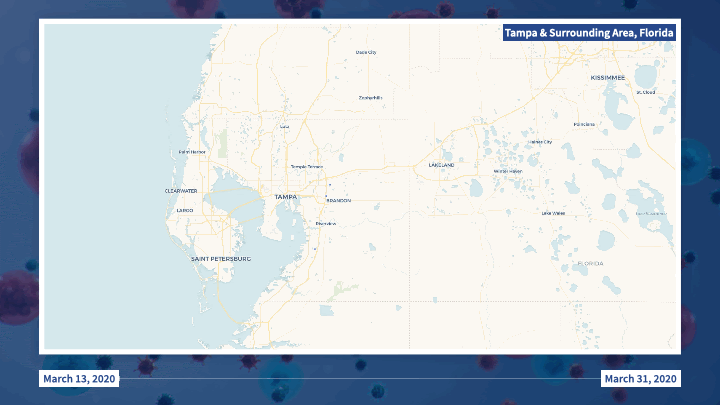State governments have implemented many strategies to motivate its communities to adopt social distancing, but how can public events impact those efforts?
Background
As of Monday, March 30, 31 states have implemented stay-at-home orders advising citizens to stay home except for food, gas, medical, or other essential services. Other states have responded to COVID-19 by closing non-essential businesses or advising at-risk people to shelter in place. In most cases, houses of worship have been designated as essential and remain open.
Today, the risk of large public gatherings during the COVID-19 pandemic is clear. Large concerts like Coachella have been rescheduled and major businesses conferences have been postponed. In many cases, postponing major public gatherings like ICSC RECon helps distance people from states that would have otherwise not come into contact with the virus as quickly had they been gathered together at the event.
Additionally, many faith communities are encouraging their members to stay home by live streaming worship services, hosting prayer meetings on Zoom, or even holding services at drive-in movie theaters.
In the early days of coronavirus in the United States, some groups gathered and unknowingly sparked outbreaks of the disease. These examples of known outbreak epicenters can be used as baselines for officials to better understand what they should expect when confronting COVID-19 in their own communities. If an event is at a high risk of exposure to novel coronavirus, this type of analysis can be applied to better understand the specific risks of an event should it not be cancelled or postponed.
Objective
Our objective was to analyze daily visitation to known public gatherings and aggregated movement data of attending devices over time to better understand the impact potential exposure in large gatherings has on surrounding communities.
Analysis
Limited Travel from Epicenter is Crucial
The timelines associated with the exposure of COVID-19 at public gatherings and the steps that state and business leadership took to contain the spread of the disease in the first few weeks of exposure is crucial to the effectiveness of their efforts, but the data shows that other variables, including the inability to travel due to the nature of the epicenter, have had a lasting impact on national spread.
Business travelers exposed to the virus traveled an average of 336.6 miles after the Biogen conference
The annual Biogen Conference in Boston responded quickly when a significant portion of the 175 Biogen executives who had traveled from all over the world to the Marriott Long Wharf hotel in Boston for the conference began reporting symptoms of coronavirus. The impact, however, was largely due to the “off-site” nature of the event: attendees still had to travel home.
Those at the Biogen epicenter during the exposure window were able to travel an average of 336.6 miles after the event. The median distance traveled for those devices was 37.8 miles.
Commuters from the suburb traveled an average of 110.8 miles after exposure at the Young Israel of New Rochelle Synagogue
The Young Israel of New Rochelle Synagogue in New York became an outbreak epicenter in early March after one of its members attended services before knowing he had coronavirus. Our recent study showed that in the 7 days before a containment zone was implemented, people present during the exposure window unknowingly traveled with the virus an average of 110.8 miles. New York currently has the most known cases of novel coronavirus in the United States.
Residents and employees of the Life Care Center of Kirkland traveled an average of 98 miles
The Life Care Center of Kirkland, a long-term care and nursing facility in Washington state, initially had a limited response to the outbreak of coronavirus. Although its response was limited, the actual travel associated with those at the epicenter during the exposure window is low compared to other outbreaks.
This is likely due to the nature of life care facilities and the inability for residents to travel. Additionally, extensive travel (to conferences, etc.) isn’t required or common for the faculty. The average distance traveled for those at the Life Care Center epicenter during the exposure window was 98.0 miles. The median distance traveled was 7.2 miles.
Suspected Epicenters: The River at Tampa Bay and Liberty University
The River at Tampa Bay
The River at Tampa Bay continues to hold large in-person services despite pleas from local officials and state directives limiting public gatherings. Hillsborough County, where The River is located, currently has 218 cases of novel coronavirus (as of Mar 29, 2020 at 10 AM).
Sunday services still happening in-person at The River

As of March 25, The River is still hosting in-person events at similar rates each week, while visitation to other churches in Florida has decreased significantly.
The River at Tampa Bay Attendees Traveled an average of 102.9 miles

People who attend large in-person events at The River have traveled to other communities across Florida and the United States, with a cumulative distance traveled of 102.9 miles from March 15 to present.
Liberty University
Liberty University in Virginia originally closed in mid March during Spring break and students traveled home. At the end of Spring break students and faculty were encouraged to return to campus. Reports of students gathering in large groups began infuriating the surrounding community and sparking an increase in Coronavirus cases among students.
Liberty University students traveled for spring break

Students and faculty at the Liberty University campus in the last two weeks of March have a cumulative distance traveled of 132.03 miles.
Conclusion
By analyzing aggregated and de-identified human movement data over time, we can better understand how groups of people react to directives from state officials and community leaders to curb the spread of the highly infections and deadly Novel Coronavirus.
Azira copyright notice and disclaimer: No reproduction or use is permitted without Azira’s express written consent.



